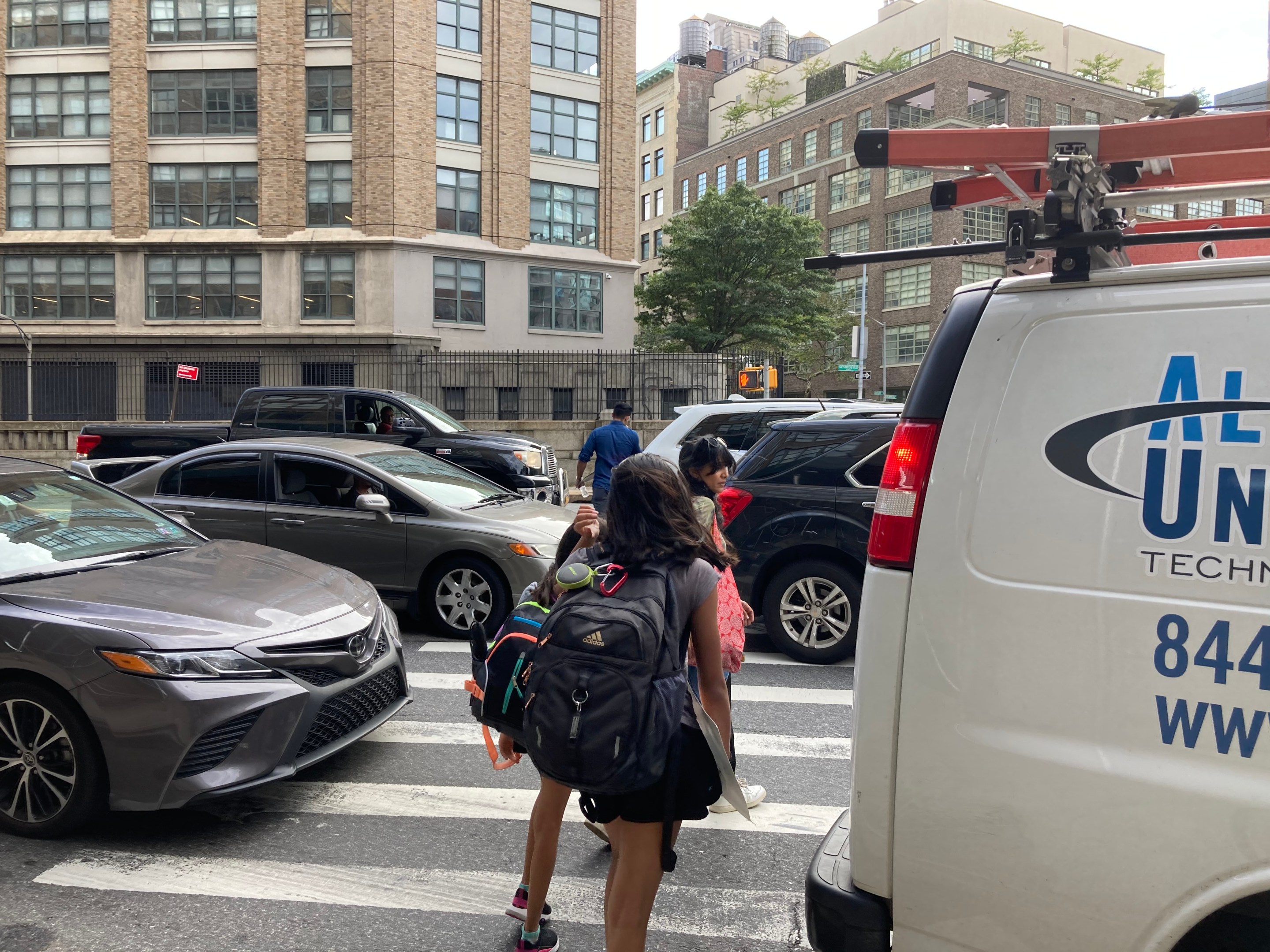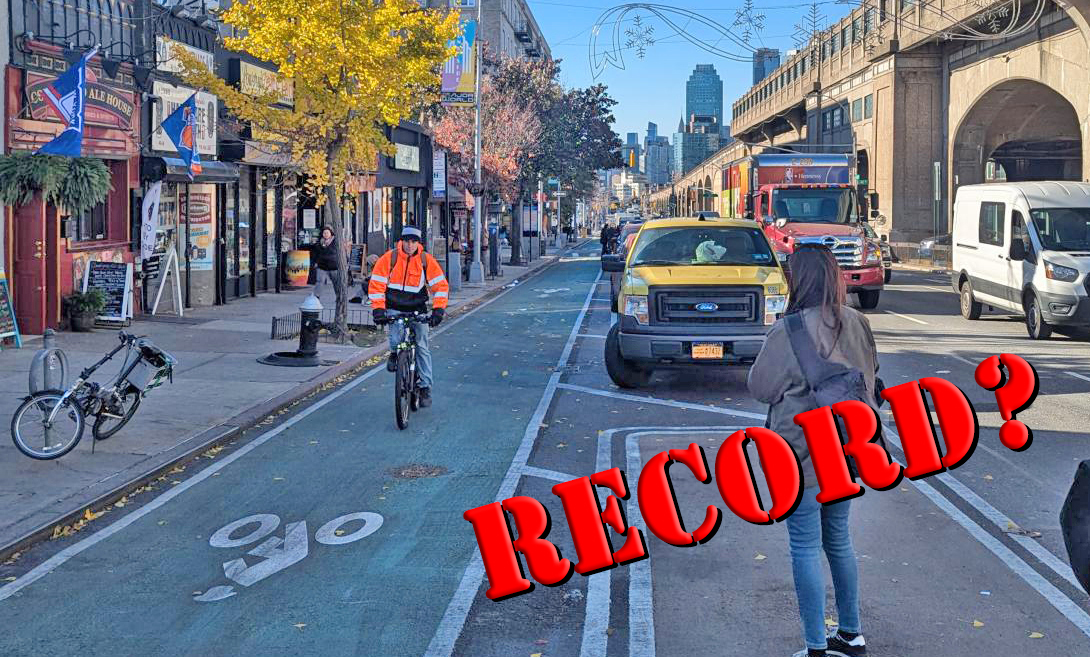Carpocalypse now.
Car drivers are basically ignoring the city's “Gridlock Alert” days for the UN General Assembly this week, driving into Manhattan in roughly the same numbers as last week, according to preliminary MTA data — a result of the mayor’s failure to create policies that get people out of cars and into mass transit on days when the city knows long in advance that roads and neighborhoods will be turned into pollution-, noise- and stress-filled parking lots, advocates said.
On Monday, the first of this week's "alert" days, a whopping 895,109 cars traveled across MTA-owned bridges and tunnels, according to the agency’s data — roughly the same as the Monday before, when no so-called alert was in effect.
And all the mayor had to say about it on Wednesday was ... the same thing he said months ago.
“I think we have a real congestion problem. There's no question. I experienced it myself," the mayor told Streetsblog on Wednesday when we asked why this week's gridlock alerts were not also coupled by serious street management policies to reduce the influx of cars. "The focus that we have is to get people out of their cars, get people back to mass transit. ... We've made a lot of announcements, obviously about expanding bike lanes, expanding bus service, busways, et cetera. I'll look at the emergency possibility. It's something that has been raised, honestly [and] it's worth another look.”
But "another look" — the same thing Hizzoner said after advocates called for carpool lanes on city bridges in advance of the carmageddon we are now all experiencing — doesn't cut it anymore, advocates and elected officials say. It's time for bold (and quick and easy) action.
“I support the mayor implementing emergency bus lanes as a means of easing congestion, making our streets safer, and promoting the widespread use of public transportation. We can not return to the status quo — it’s imperative that we seize this moment and create lasting change in the Central Business District," said Manhattan Council Member Keith Powers.
Advocates and elected officials last year warned of a looming carmageddon, and begged de Blasio to follow the lead of other cities around the world and address the coming problem with pop-up bus lanes and high-occupancy vehicle policies — like those enacted after 9/11 and during a three-day transit strike in 2005. But he didn’t listen, and the result is exactly as imagined — a murder of private vehicles and trucks choking neighborhoods that’s forced buses to divert their routes away from congested areas, and has made pedestrians increasingly fearful of crossing the street.
Last summer, Riders Alliance was one of several advocacy groups to demand the mayor make room for 40 miles of “emergency” dedicated bus lanes to help long-suffering transit riders — many of them low-income essential workers — as cars started flooding back onto roads. And the MTA even one-upped that, asking for 60 miles of bus lanes to speed up the city’s recovery.
But the mayor failed to hit both that goal, and even his own of 20 miles of dedicated bus lanes and car-free busways, instead installing about just 16 miles by the end of last year, Streetsblog reported.
“If terrible traffic doesn't discourage driving, neither will alerts without something to back them up,” said Danny Pearlstein of Riders Alliance. "Meanwhile, bus riders suffer and emergency response times spike. Whether it's emergency bus lanes or busways, HOV restrictions, transit discounts, the city and state need to do more to ensure the delivery of essential services in public space."
Today we welcomed our Pedestrian Safety Managers back for the first time since NYC's lockdown in 2020. 🙂 #NYCReopening pic.twitter.com/SFbayDErNv
— Hudson Square BID (@HudsonSquareNYC) September 22, 2021
And more data crunched by transit expert Charles Komanoff shows traffic is not only holding steady, but getting worse, especially within the Central Business District.
The number of cars entering the CBD via the Queens-Midtown and Brooklyn-Battery tunnel this Sept. 1 through Sept. 18 was 1,373,105 — up 2.4 percent from the same time period in 2019, according to MTA data obtained by Komanoff.
And the data is more than just numbers, but has real world implications that hurt communities, essential workers and pedestrians — the latter are currently being helped in the long-suffering neighborhood near the Holland Tunnel with "Pedestrian Safety Managers" hired by the Hudson Square Business Improvement District. MTA buses don't have such help — the agency truncates bus routes west of Varick Street whenever there's "heavy traffic."
“‘Bus service is suspended because of heavy traffic’ is one of those things that should provoke an all-hands-on-deck response from city government. Emergency bus lanes. HOV requirements for entering Manhattan. The list goes on,” Doug Gordon, co-host of The War On Cars podcast wrote on Twitter on Sept. 21, day two of the full week of gridlock alerts.
But the mayor did none of those things, instead he merely asked people nicely not to drive.
“The General Assembly is in session this week, so there is a Gridlock Alert in effect through Friday. Don’t drive if you can avoid it and expect delays and difficulties with parking if you do, especially around Midtown East,” the Mayor’s Office said on Sept. 20.
REMINDER: The @UN General Assembly is in session this week, so there is a Gridlock Alert is in effect through Friday. Don’t drive if you can avoid it and expect delays and difficulties with parking if you do, especially around Midtown East. pic.twitter.com/WbZsOVrvZZ
— NYC Mayor's Office (@NYCMayorsOffice) September 20, 2021






